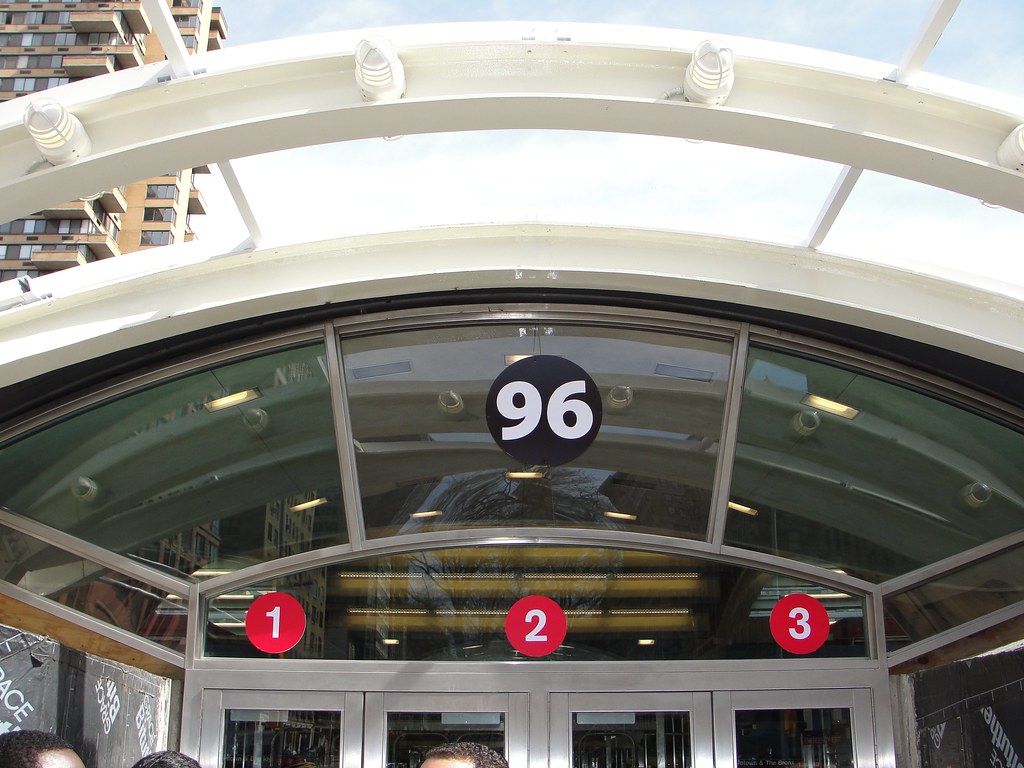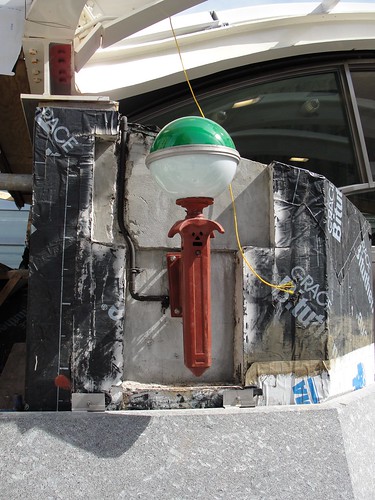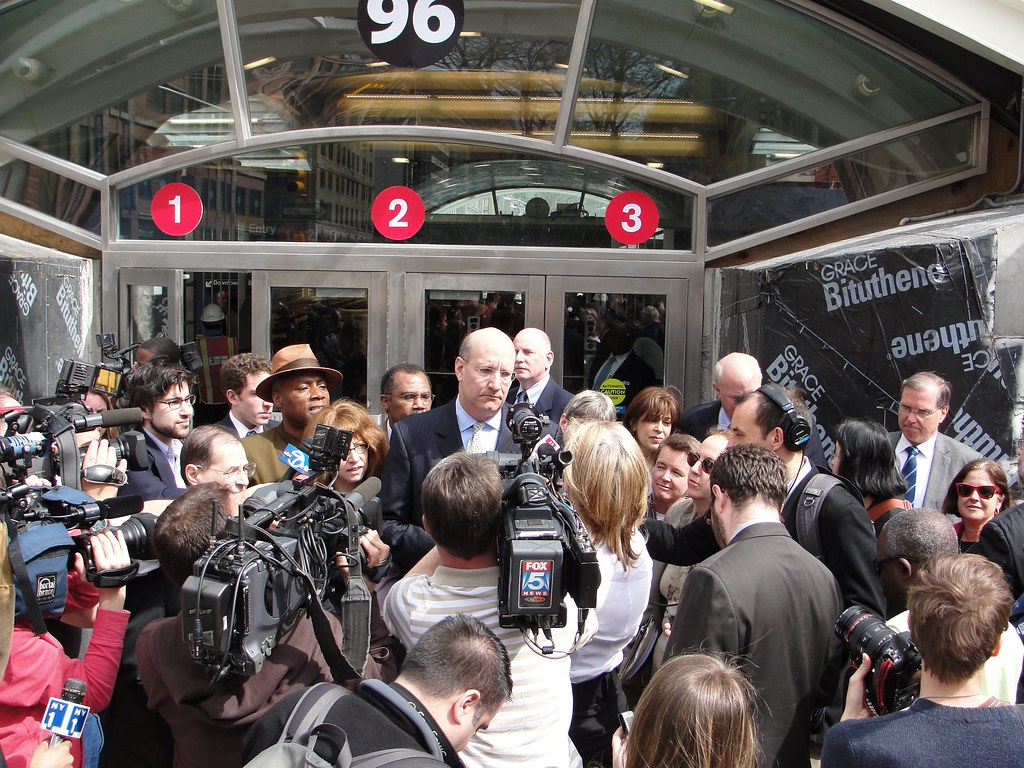The new stationhouse at 96th St. and Broadway is now open for business. (All photos by Benjamin Kabak)
Shortly after 11 a.m. this morning, the new stationhouse in the median of Broadway between 95th St. and 96th St. opened for business. Although the station rehabilitation isn’t set to wrap up until September and the stationhouse itself is far from finished, Upper West Side commuters bound for the express stop will find it easier to access the station’s platforms and transfer between the uptown and downtown trains.
As part of the opening ceremonies, the MTA invited a slew of board officials and local representatives to tour the station and discuss the opening. The station remains very much a work in progress, but the MTA says the 40-month, $98-million project is still on time and still on budget. With the opening of the new headhouse, straphangers can now walk directly down from the fare control areas to the platforms, and no longer have to walk below the track level and then up to the platform. Eventually, the station will be fully ADA-compliant with two elevators and an access ramp to the headhouse, and the below-platform walkway will be retained as a transfer point.
During his talk with reporters, MTA Chairman and CEO spoke about the progress the authority has made in modernizing its system. The new headhouse, he said, is opening ahead of schedule because those who live on the Upper West Side have asked the MTA to make accessing this station in progress easier. “We’re proud of how far we’ve come from the dark ages,” he said, “but at the same time we’re not satisfied with the level of service we provide.”
Others were a bit more guarded with their praise. Andrew Albert, the New York City Transit Riders Council’s non-voting representative to the MTA Board, spoke forcefully to me about the juxtaposition between the MTA’s capital improvements and the looming service cuts. “I think it’s wonderful that we’re opening wonderful new stations,” he said, noting how the rehabilitation of 96th St. will make it a more user-friendly station. “But it’s a dichotomy when you consider the service to be cut running through these stations.”
Despite its in-progress state of being, the new headhouse is a vast improvement over the old cramped and decrepit entrances that marred the northern end of the system’s 27th busiest stop. The inside is now light and airy with numerous turnstiles and wide staircases. Those waiting above can spy on passengers as they board the train, and the new headhouse even has a fully-functional station booth, a rare sighting in this day and age.
Outside, granite blocks and metal benches serve as a resting spot in the pedestrian plaza on the north side at 96th St. still under construction. Still, though, the station is amidst two lanes of traffic on Broadway, and project planners have worked with the community to limit the dangers. Lois Tendler, the Vice President for Government and Community Relations, talked to me about her work with the Upper West Side Community Board and the area’s elected representatives. NYC DOT narrowed traffic lanes at 95th St., and although sidewalk width on either side of Broadway was cut back from 24 feet to 15 feet, all parties believe pedestrians will still be safe. “People cross streets all the time in New York,” Tendler said.
Meanwhile, the old entrances at the southeast and southwest corners of 96th and Broadway are now closed. Although the neighborhood may mourn the loss of those entrances, the new staircases that lead directly from the platform to the street eliminate that pesky down-up-up exit and down-down-up entrance that used to make the northern end of 96th St. so inefficient.
After the jump, a slideshow of my photos from the afternoon. You can also view the entire photoset on Flickr.





30 comments
Andrew Albert, the New York City Transit Riders Council’s non-voting representative to the MTA Board, spoke forcefully to me about the juxtoposition between the MTA’s capital improvements and the looming service cuts. “I think it’s wonderful that we’re opening wonderful new stations,” he said, noting how the rehabilitation of 96th St. will make it a more user-friendly station. “But it’s a dichotomy when you consider the service to be cut running through these stations.”
That’s a non-sequitur. In the first place, 1/2/3 service is not seeing significant cuts. In the second place, the rehab at 96th Street began long before the current budget crisis was anticipated. And finally, the rehab was funded out of the capital budget, which is an entirely different funding source than the operating budget.
I believe off-peak 1 service is slated to be reduced somewhat. (And the off-peak 1 is already pretty crowded, in my experience.)
I don’t think the 2 or 3 is being touched this time around.
[…] out all of our coverage here. And read more about the station at Second Avenue Sagas. (Tweetphoto by […]
@Marc Yes, all true. However, most NY’ers don’t see that. They see a few new shiny stations and hear about the mega projects like ESA, SAS and FTC, while the MTA and the politicians bicker over money with passengers caught in the middle. To them, it is a dichotomy and it isn’t a false one.
The public genuinely doesn’t understand how the MTA works. I don’t blame them, it isn’t be discussed by the people who are supposed to explain it, the politicians and the media. I don’t blame them for not taking the time to find out either as most people have a lot going on in their lives and it’s not exactly the most interesting subject for most people.
The gut level questioning about priorities of the MTA, City Hall and Albany are good ones. The real question is: have real estate taxes, city and state funding and toll revenues from the Triboro Bridge Authority, created a steady source of funding for our city’s transportation needs? Apparently not. So now is the time to put everything back on the table for discussion. To re-examine “immutable truths” and re-think what sort of system of organization we want to run and fund our transportation system.
It’s easy to let systemic problems slide during good times, because there’s plenty of money to cover it. In tough times however, things can’t be allowed to slide any longer. Now is the time to open the broader questions for the MTA, NYC, NYS and the Federal Government. Is our current organizational system working? Has the “free-market” really achieved what was promised, or has it fallen flat? Have “trickle down” economics worked, or has it left our nation’s economy and infrastructure in a shambles? Has shifting the tax burden from the wealthy to the working and middle classes kept our institutions fully funded? Are bureaucratic union structures fighting for the status quo, actually standing in the way of expansions of their membership? Do huge salaries and bonuses for executives really lead to better performance or do they lead to a sense of entitlement and massive cost inflation at the top? Do permanently incumbent machine politicians in Albany and City Hall really have their voter’s wishes at heart, or are they all just playing their own game?
These questions, while beyond the scope of this website are all part of the systemic issues that are influencing what is going on. To discuss the micro, without thinking about the macro is myopic.
All valid, but you expect a member of the MTA board (albeit a non-voting member) to be better informed.
His point wasn’t one of conflating the capital and operations budget. If that’s your takeaway, that’s my fault for writing it up as such. Andrew Albert recognizes the two different budgets but is critical of politicians for backslapping over capital improvements in the face of operations deficits. He’s one of the better informed MTA Board members.
What is going on with the “1/2/3” up there? It doesn’t fit the established design standards of the MTA signage system and as such it’s confusing. Those numbers should be grouped together. Right now it looks like it’s number the doors. Or something. That arrangement doesn’t make any sense from wayfinding or branding perspective.
It’s part of the temporary nature of the unfinished headhouse. Because the station isn’t finished yet, the MTA doesn’t have all of the elements in place.
Ah. Thank God. I”ve seen too many decisions like this made by someone not authorized to make the decision or with any understanding of signage within the system at other transit agencies that then become permanent. It’s good to know there’s still some top down design discipline coming eventually. 😉
No, those bullets are clearly part of the artistic design – they are most certainly not temporary. And Christopher is correct; they violate the MTA’s signage design standards. (Whether art trumps standards I’ll leave for others to decide.)
Those bullets are cardboard that are currently tied to the station and taped on. I was there; I saw them. Why do you think they’re not temporary? The stationhouse isn’t even finished yet.
For one thing, 72nd Street has the exact same treatment:
http://www.nycsubway.org/perl/show?54289
Oh oh. I see what you were saying. The bullets will look different from the MTA’s usual signage. But what’s up now are the final bullets.
I hope someone asked Linda Rosenthal about her signature on the gutless letter by Brodsky to the MTA about student metrocards and the “negligible” cost for students to travel on NYCT (justification for the MTA to foot the entire bill).
She is quick to bask in the glamour of a station opening, but is also more than happy to gut funding for the MTA in the State Assembly. She needs to be called out on this more.
Btw, she is just to the right of Walder (glasses, red hair) in Ben’s top picture.
Meanwhile, stations like 21st-Van Alst and Chambers (J,M) have rotted for years, and will continue to…
I’ll really miss the street entrances. I always used to go around to the second ones to avoid the crowds – everyone seemed to forget about those. I’m not keen about having the only (northside) entrance on Broadway. It would be nice if there had been enough money to extend the existing street entrances under 96th. Oh well, maybe next century.
I too wish they’d retained the sidewalk entrances, to diffuse the crowd, to keep options open, and to avoid unnecessary costs of closure (de)construction. One misses well-worn footsteps. The new station in itself is ok: but will they really keep live people staffing the booth? I hope so, but I’ll believe it only so long as I see it. I hate the machines, and further, regard the human staff as part of public safety. (The people working the ticket booth are unfailingly courteous; and anyone who didn’t want to be bothered selling tickets by hand could be easily replaced in the current unemployment.)
[…] New 96th St. Subway Station Features Wider Stairs, Skinnier Sidewalks (City Room, SAS) […]
It is exciting to see improvements in mass transit facilities. Infrastructure that is attractive and easy-to-use makes everyone’s day more enjoyable.
At the same time, it is disappointing that once again members of a wealthy community on the Upper West Side get a nice amenity whereas those of us uptown and in outer boroughs continue to suffer with degrading transit infrastructure (for example, the 181st IRT station).
[…] Inside thenew headhouse at 96th St. and […]
If this were another city with a boastful subway system, you’d see special TV programs that feature the opening of the station, reminiscent of “propaganda-like” ads running on TV. Of course, the MTA could just make one to upload onto their site to better their PR but noo…..
Looks great, and reminds me of the PATH Head House at NewPort/Pavonia in terms of the entry access through a segregated, garden path. Now, hopefully they can keep this station clean for more than a month…
I don’t know why there are so many complaints surrounding the updates to the 96th Street Station. Considering that the station itself is one of the busiest in the system it was an absolute cluster f*ck to get through to reach your train using the 96th Street entrance. While other stations are in dire need of repair like the stations along the Culver viaduct, those are at least managable to navigate. Concerning 181st Street, the ceiling fell in long after funds were allocated for 96th. It’s not like they can or should stop work on a nearly completed project to attend to a new problem. Otherwise nothing would ever get finished and there would be complaints about that. With all the problems present with our subway system we should at least be greatful that the MTA is trying it’s best to update the system as best it can with the funds that are available.
181st was rehabbed in the late 90’s; until the current project began, 96th hadn’t been touched since it was extended in the 50’s.
There are plenty of stations all over the city that have been rehabbed – while the two stations directly to the south of this one, as well as most of the Central Park West stations, have not.
Great that the crowding is relieved!
But it’s an eyesore.
It looks like a big glass turtle and doesn’t fit in with the neighborhood style. Some architect imposing his own ego on the rest of us.
new station at 96th & Broadway, another grand bad design, waste of money MTA, when will it end? better idea to be run by the Metropolitan Etiquette Authority?
[…] April, the MTA held a ribbon-cutting ceremony for the new stationhouse at 96th St. and Broadway, but at the time, the project wasn’t […]